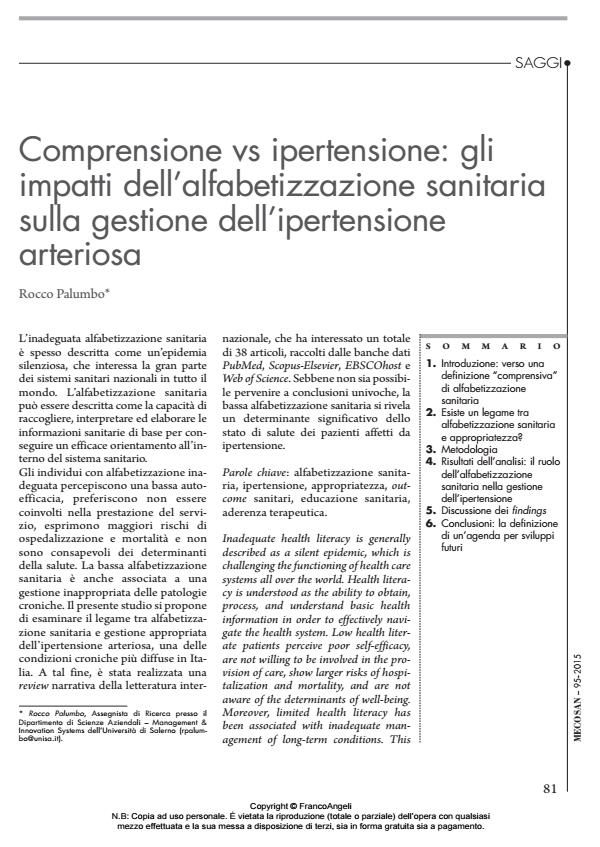Comprensione vs ipertensione: gli impatti dell’alfabetizzazione sanitaria sulla gestione dell’ipertensione arteriosa
Titolo Rivista MECOSAN
Autori/Curatori Rocco Palumbo
Anno di pubblicazione 2016 Fascicolo 2015/95
Lingua Italiano Numero pagine 27 P. 81-107 Dimensione file 20329 KB
DOI 10.3280/MESA2015-095005
Il DOI è il codice a barre della proprietà intellettuale: per saperne di più
clicca qui
Qui sotto puoi vedere in anteprima la prima pagina di questo articolo.
Se questo articolo ti interessa, lo puoi acquistare (e scaricare in formato pdf) seguendo le facili indicazioni per acquistare il download credit. Acquista Download Credits per scaricare questo Articolo in formato PDF

FrancoAngeli è membro della Publishers International Linking Association, Inc (PILA)associazione indipendente e non profit per facilitare (attraverso i servizi tecnologici implementati da CrossRef.org) l’accesso degli studiosi ai contenuti digitali nelle pubblicazioni professionali e scientifiche
L’inadeguata alfabetizzazione sanitaria e spesso descritta come un’epidemia silenziosa, che interessa la gran parte dei sistemi sanitari nazionali in tutto il mondo. L’alfabetizzazione sanitaria puo essere descritta come la capacita di raccogliere, interpretare ed elaborare le informazioni sanitarie di base per conseguire un efficace orientamento all’interno del sistema sanitario. Gli individui con alfabetizzazione inadeguata percepiscono una bassa autoefficacia, preferiscono non essere coinvolti nella prestazione del servizio, esprimono maggiori rischi di ospedalizzazione e mortalita e non sono consapevoli dei determinanti della salute. La bassa alfabetizzazione sanitaria e anche associata a una gestione inappropriata delle patologie croniche. Il presente studio si propone di esaminare il legame tra alfabetizzazione sanitaria e gestione appropriata dell’ipertensione arteriosa, una delle condizioni croniche piu diffuse in Italia. A tal fine, e stata realizzata una review narrativa della letteratura internazionale, che ha interessato un totale di 38 articoli, raccolti dalle banche dati PubMed, Scopus-Elsevier, EBSCOhost e Web of Science. Sebbene non sia possibile pervenire a conclusioni univoche, la bassa alfabetizzazione sanitaria si rivela un determinante significativo dello stato di salute dei pazienti affetti da ipertensione.
Parole chiave:Alfabetizzazione sanitaria, ipertensione, appropriatezza, outcome sanitari, educazione sanitaria, aderenza terapeutica
- La riorganizzazione delle prestazioni sanitarie in ottica di appropriatezza: l'esperienza dell'AOU "San Giovanni di Dio e Ruggi d'Aragona" nella gestione del DRG 127 - Insufficienza cardiaca e shock Lucia Soriente, Silvio Cigolari, Alberto Gigantino, Chiara Aliberti, Pasquale Ardovino, Paola Adinolfi, Rocco Palumbo, in MECOSAN 115/2021 pp.7
DOI: 10.3280/MESA2020-115002
Rocco Palumbo, Comprensione vs ipertensione: gli impatti dell’alfabetizzazione sanitaria sulla gestione dell’ipertensione arteriosa in "MECOSAN" 95/2015, pp 81-107, DOI: 10.3280/MESA2015-095005